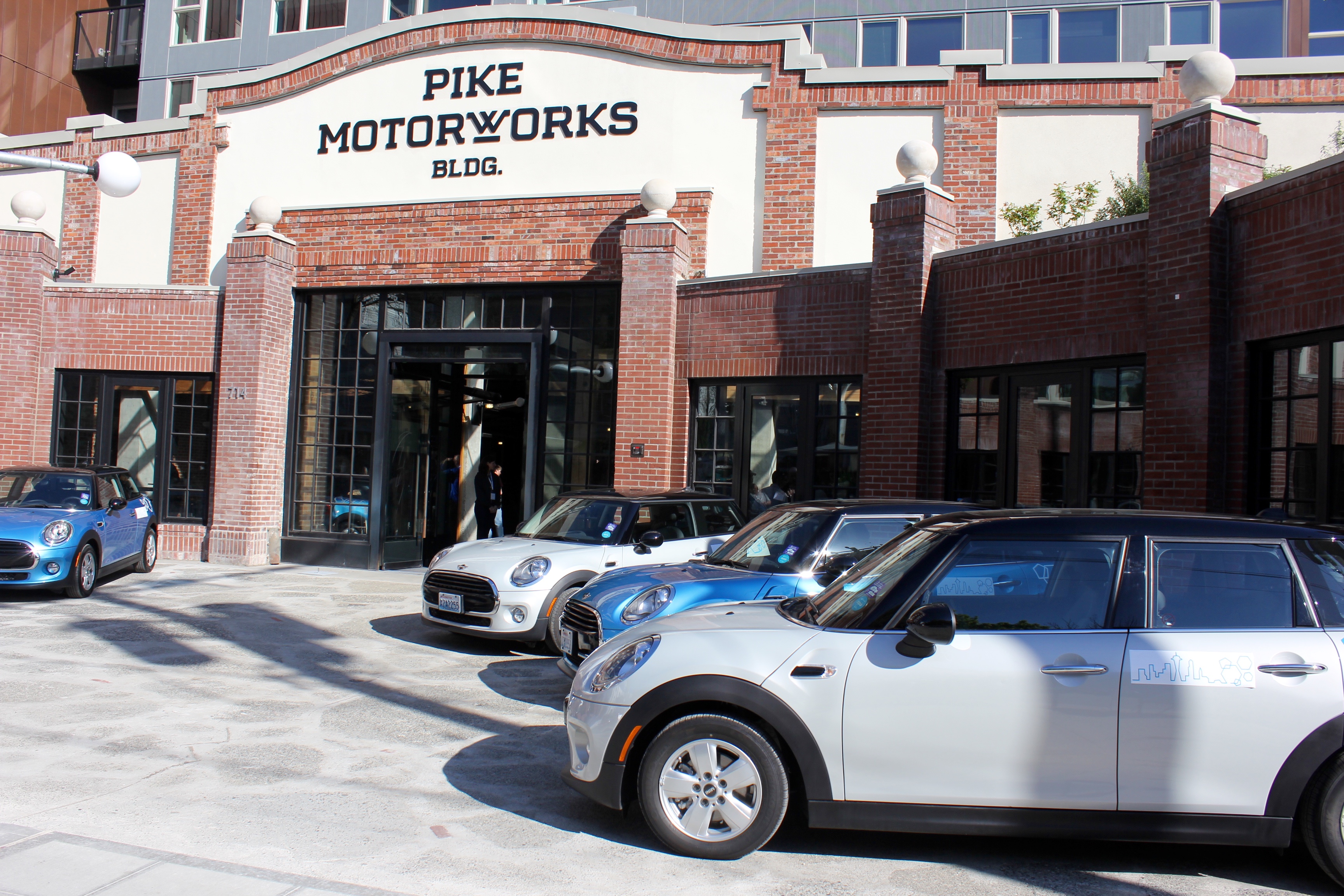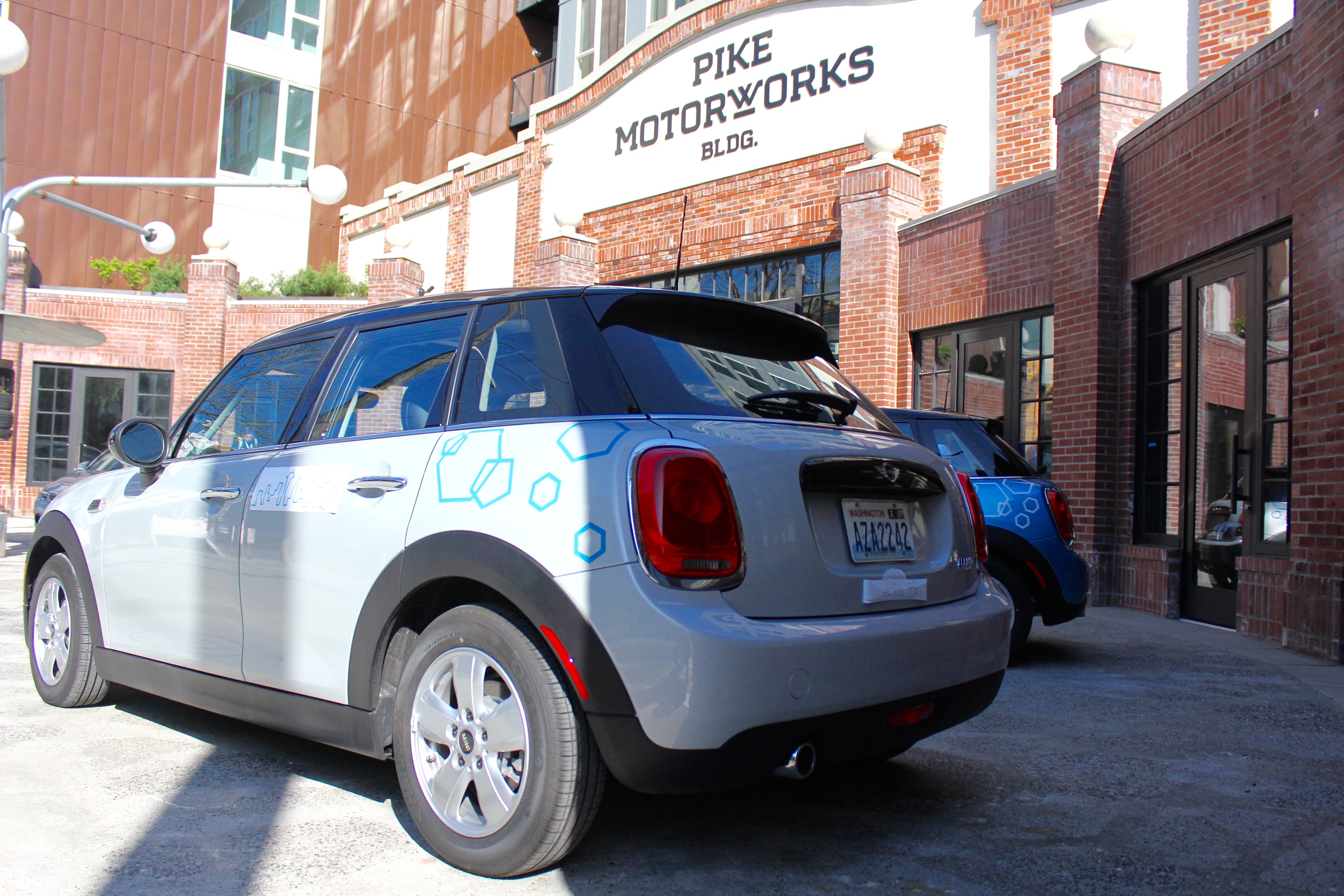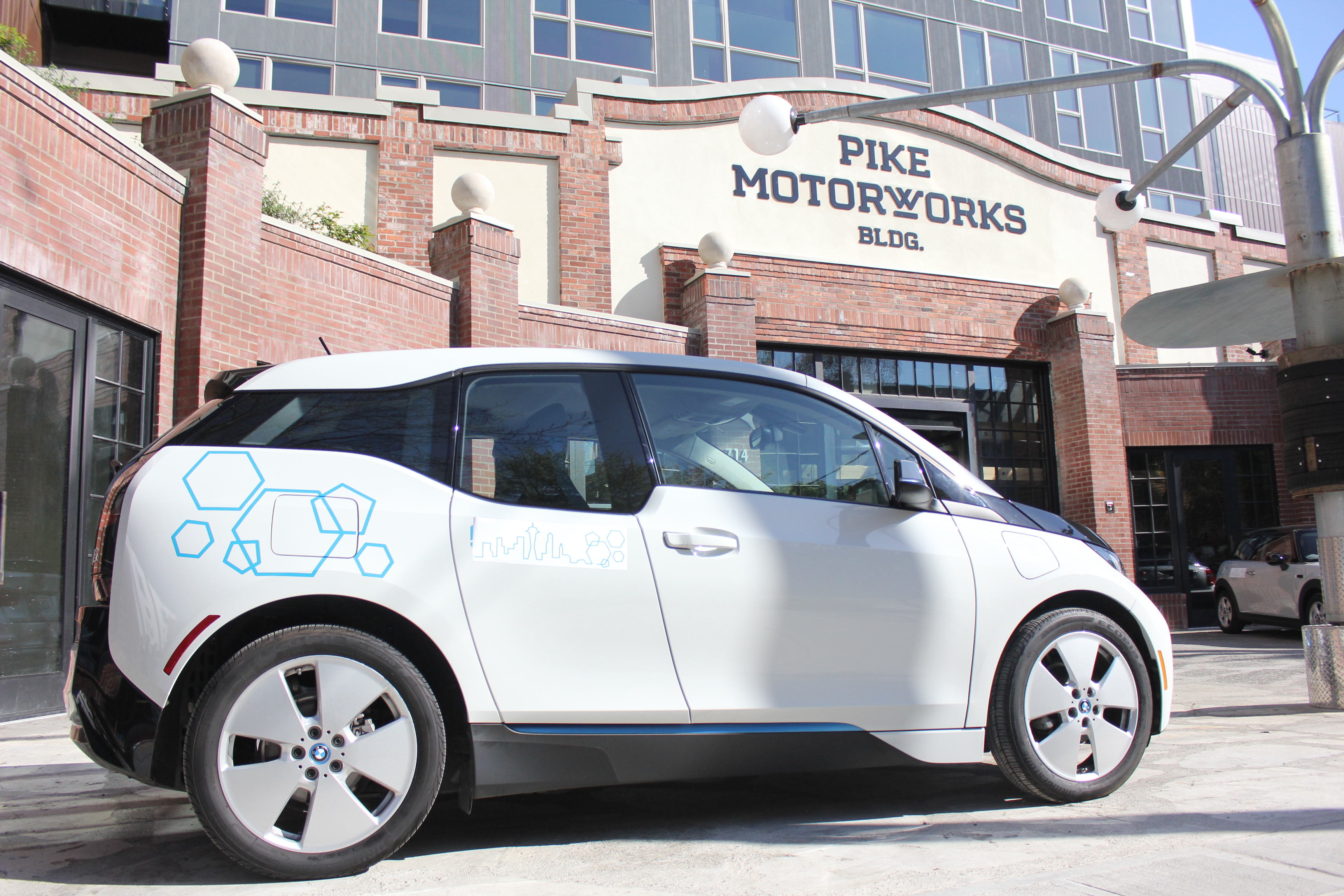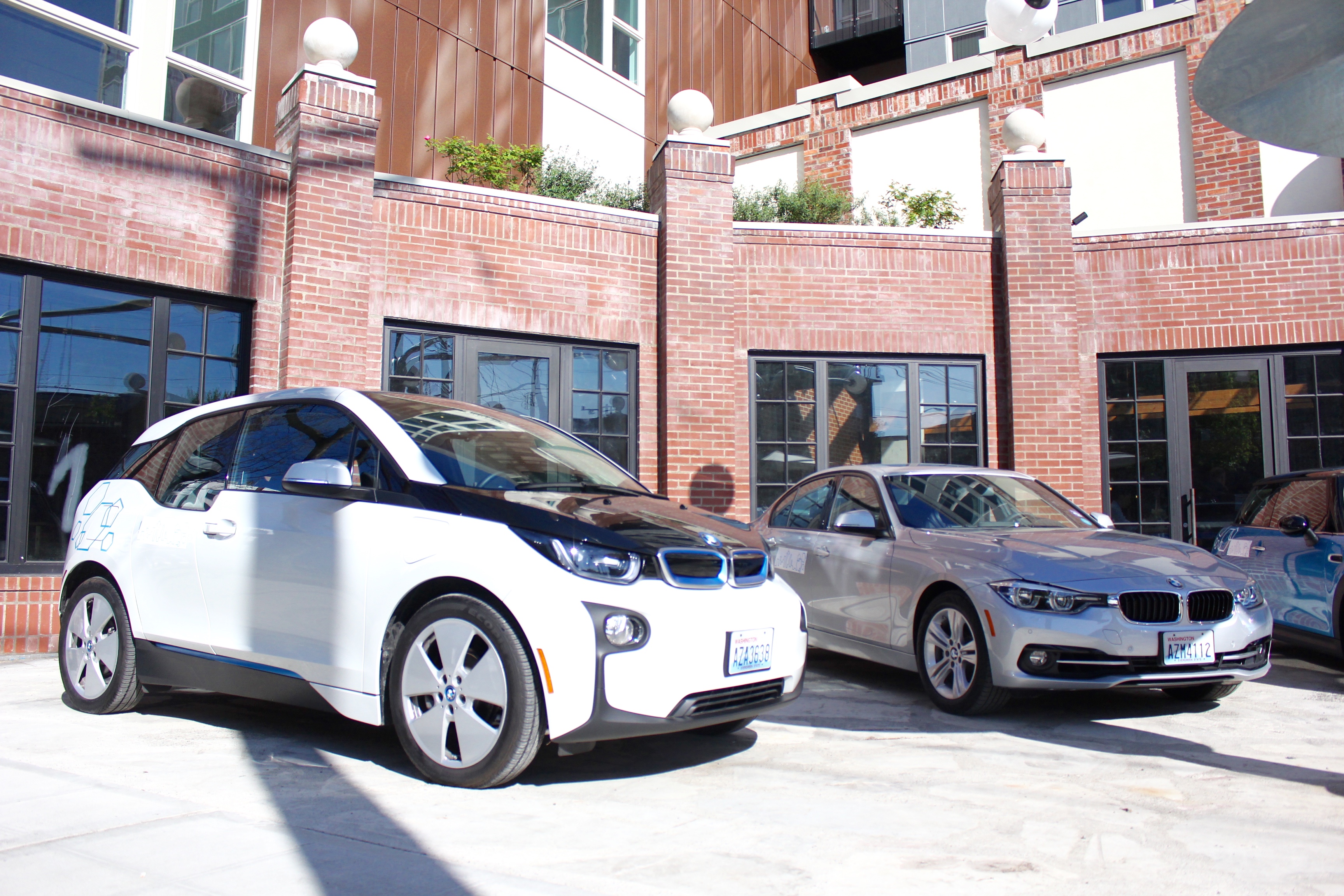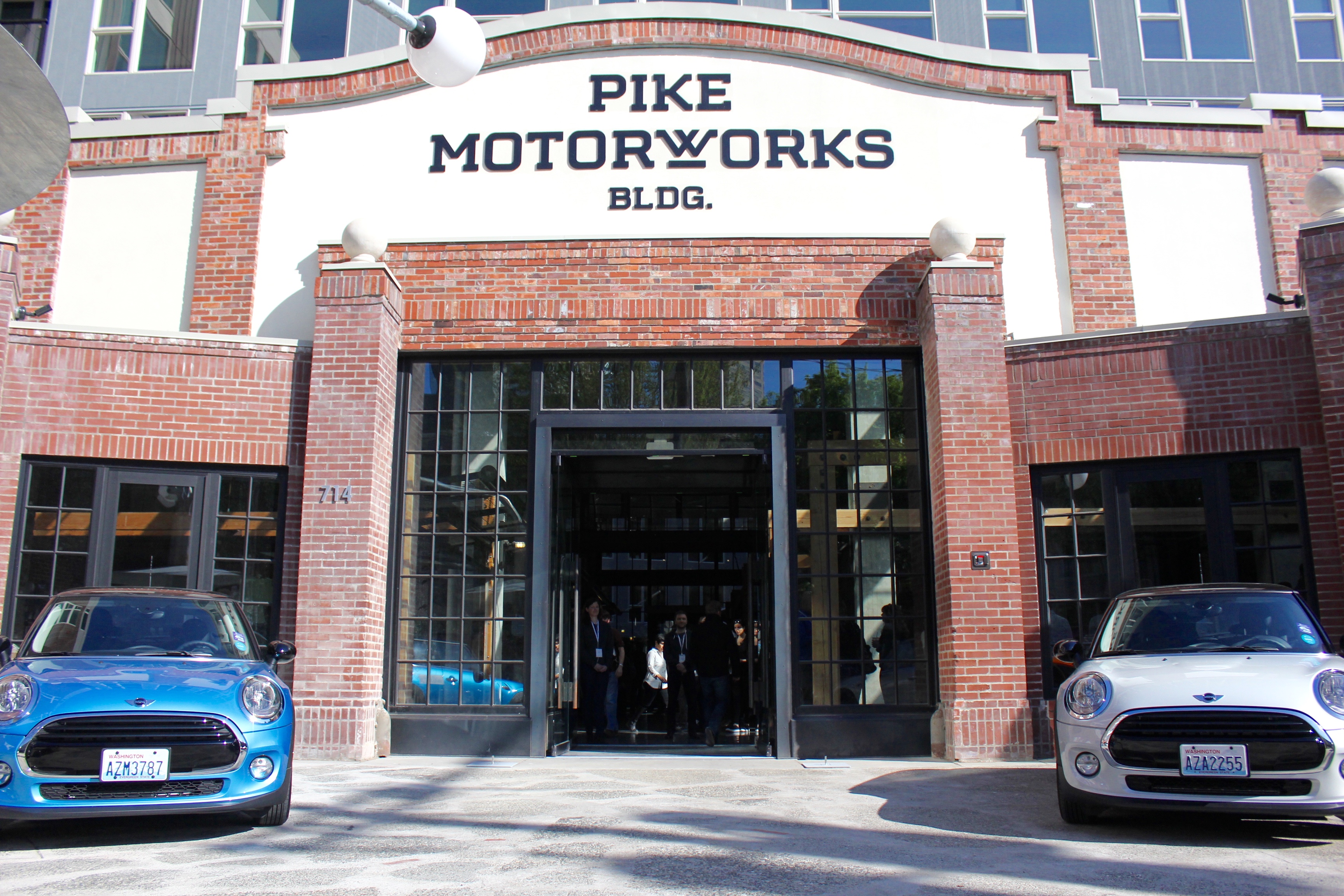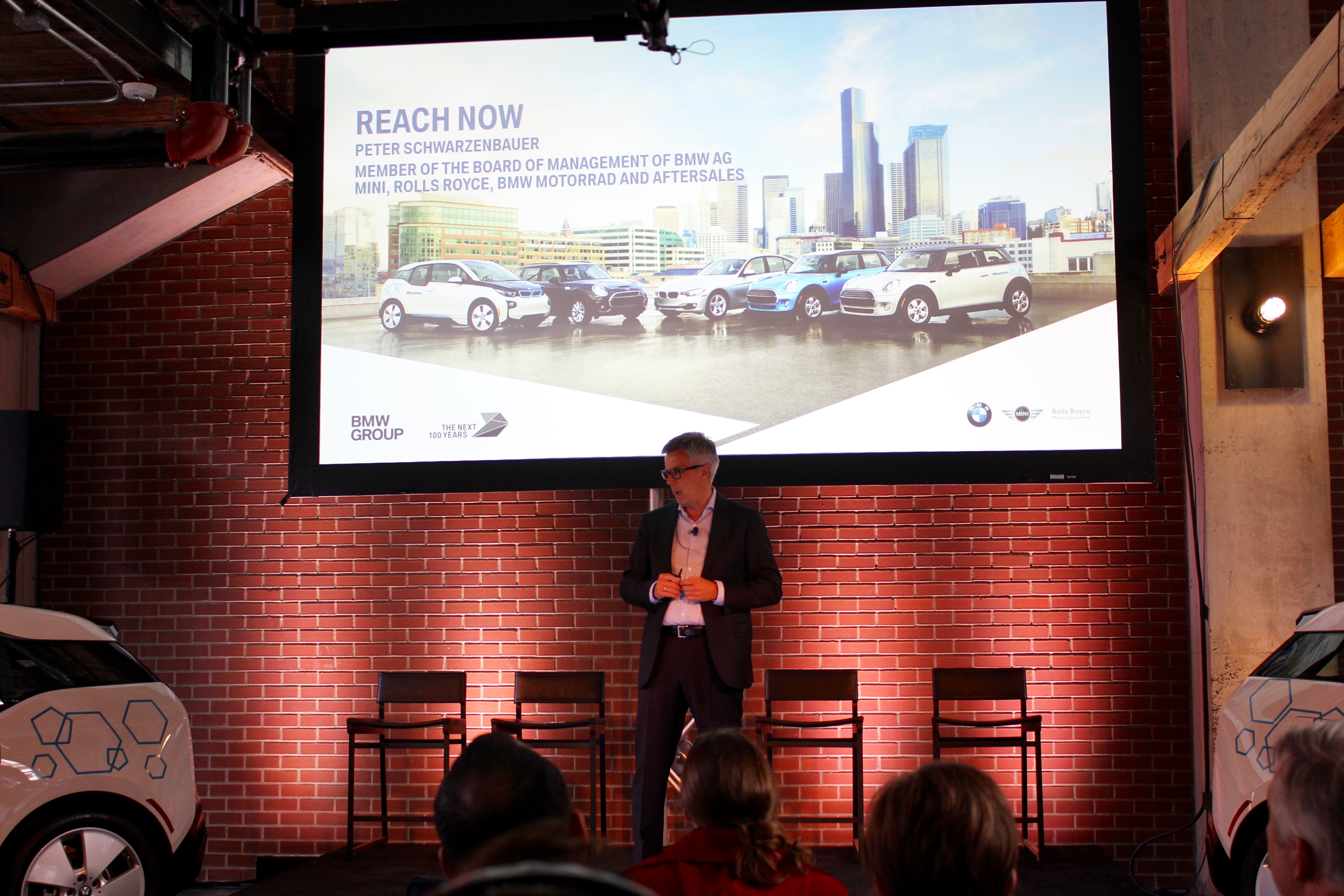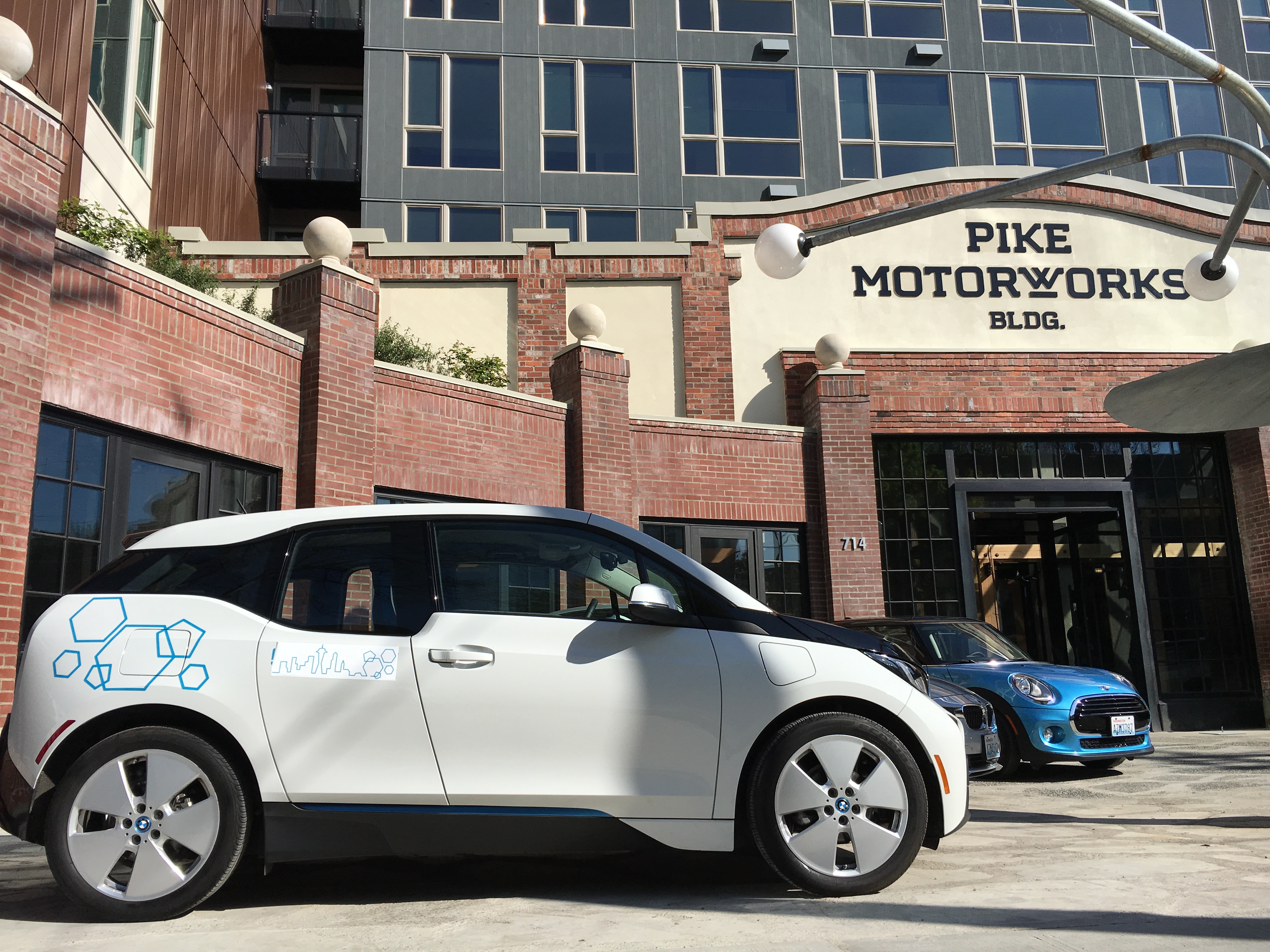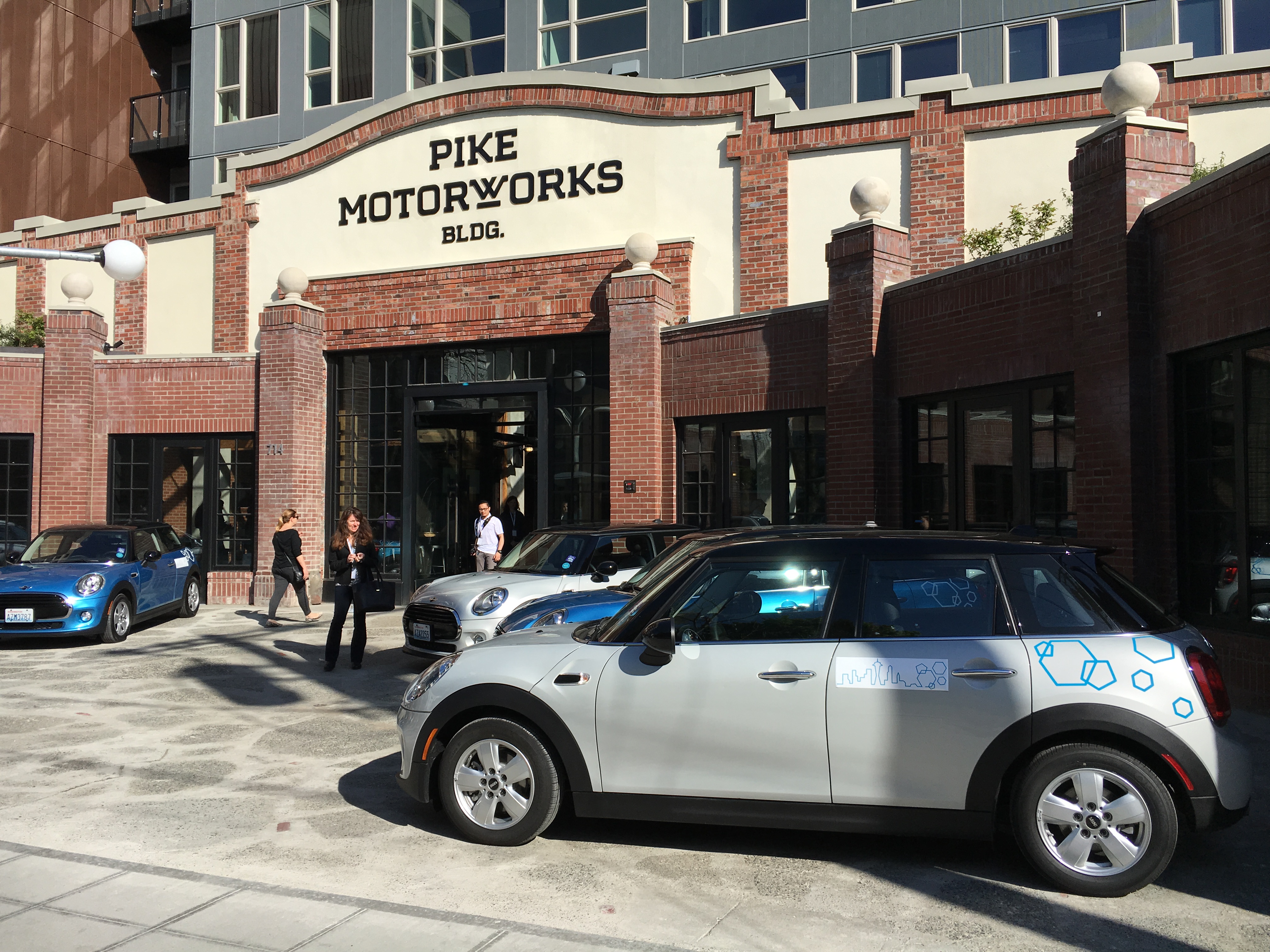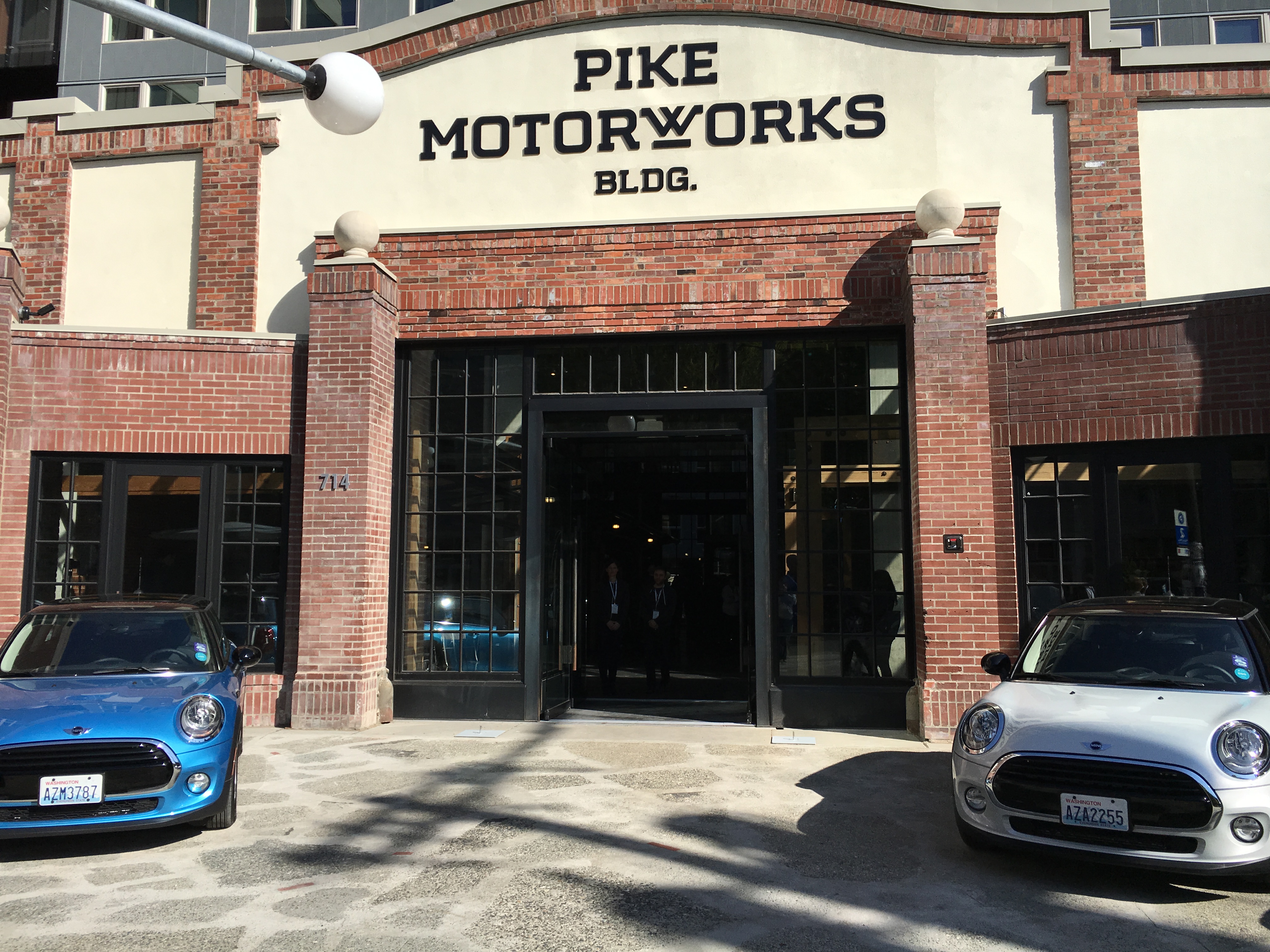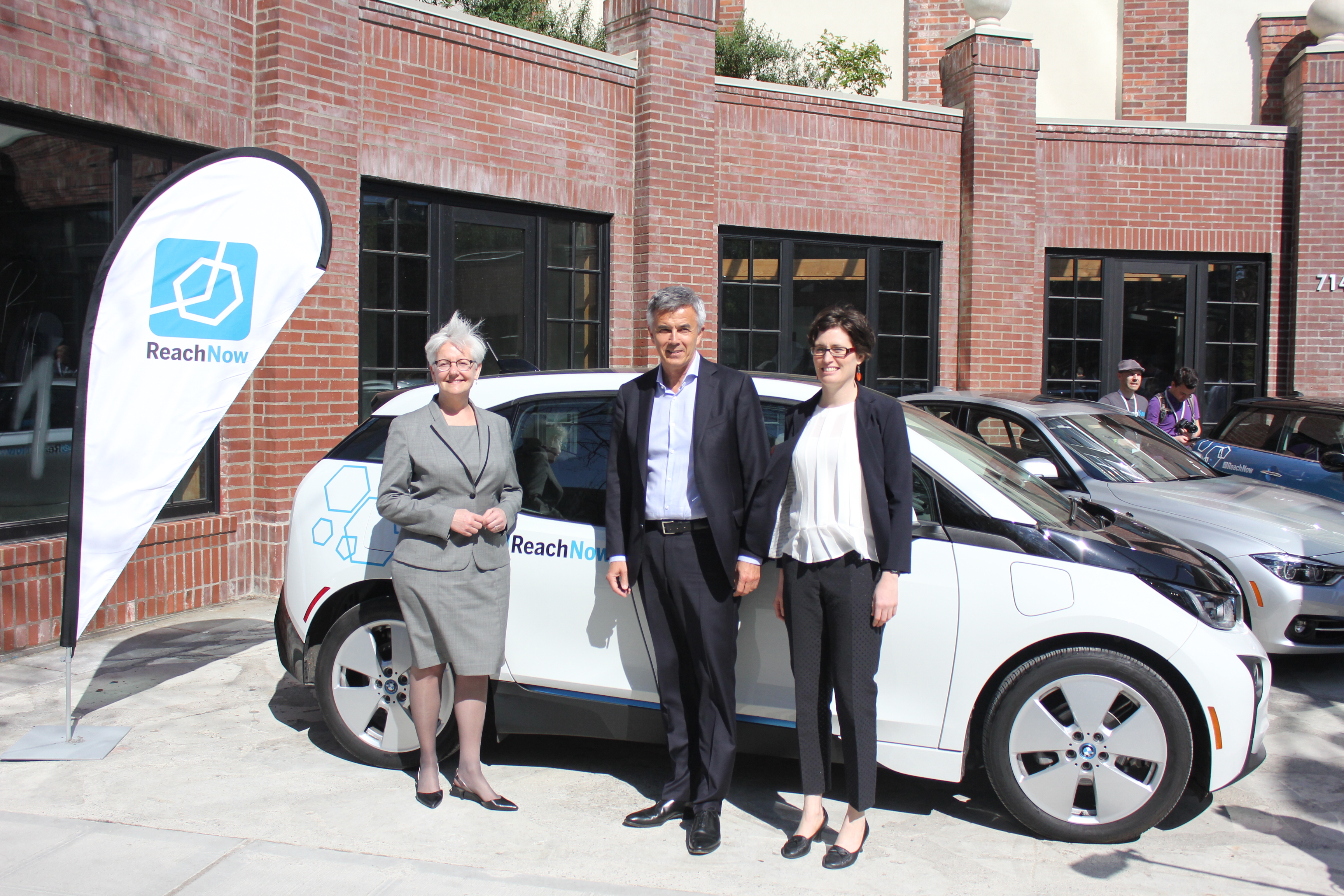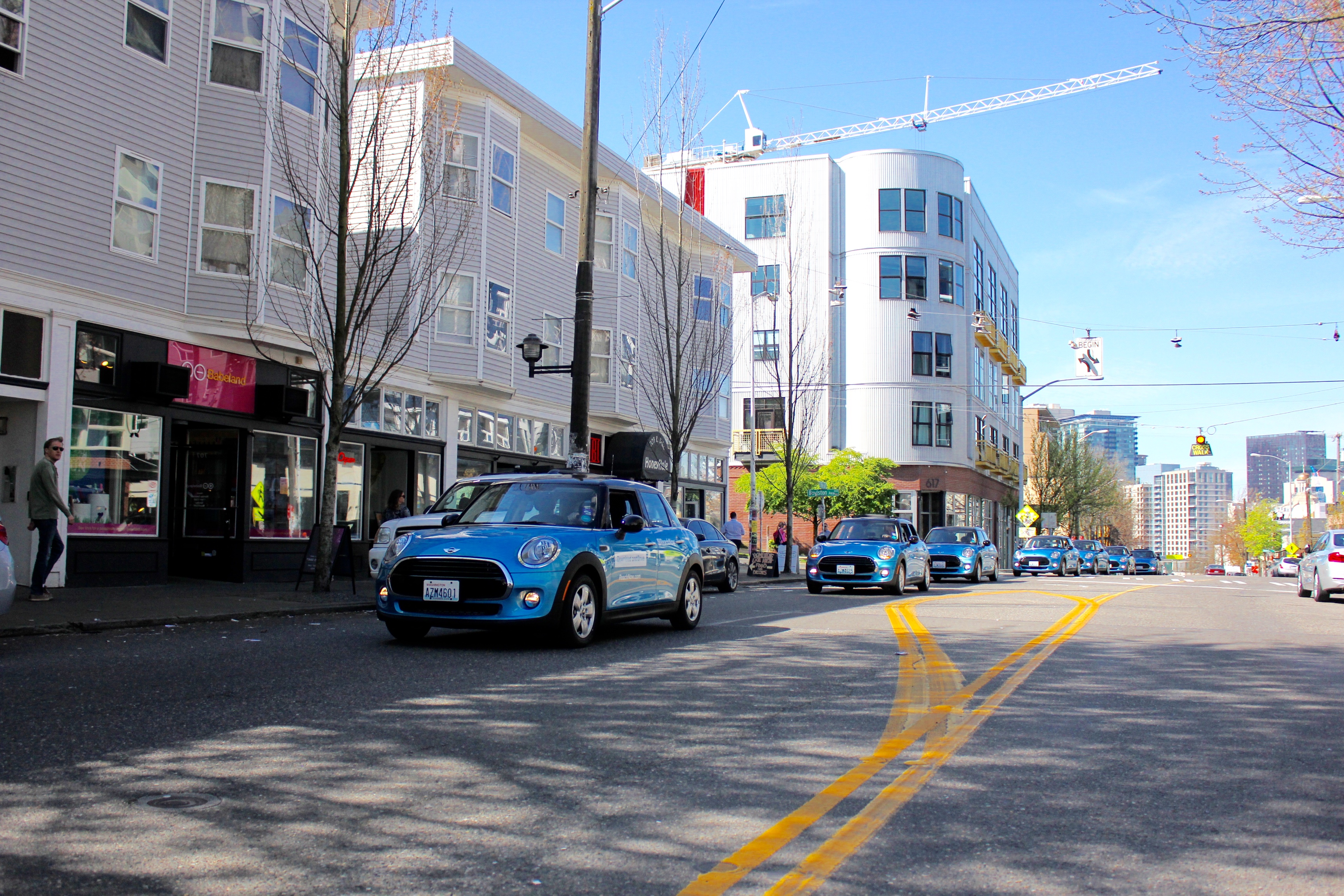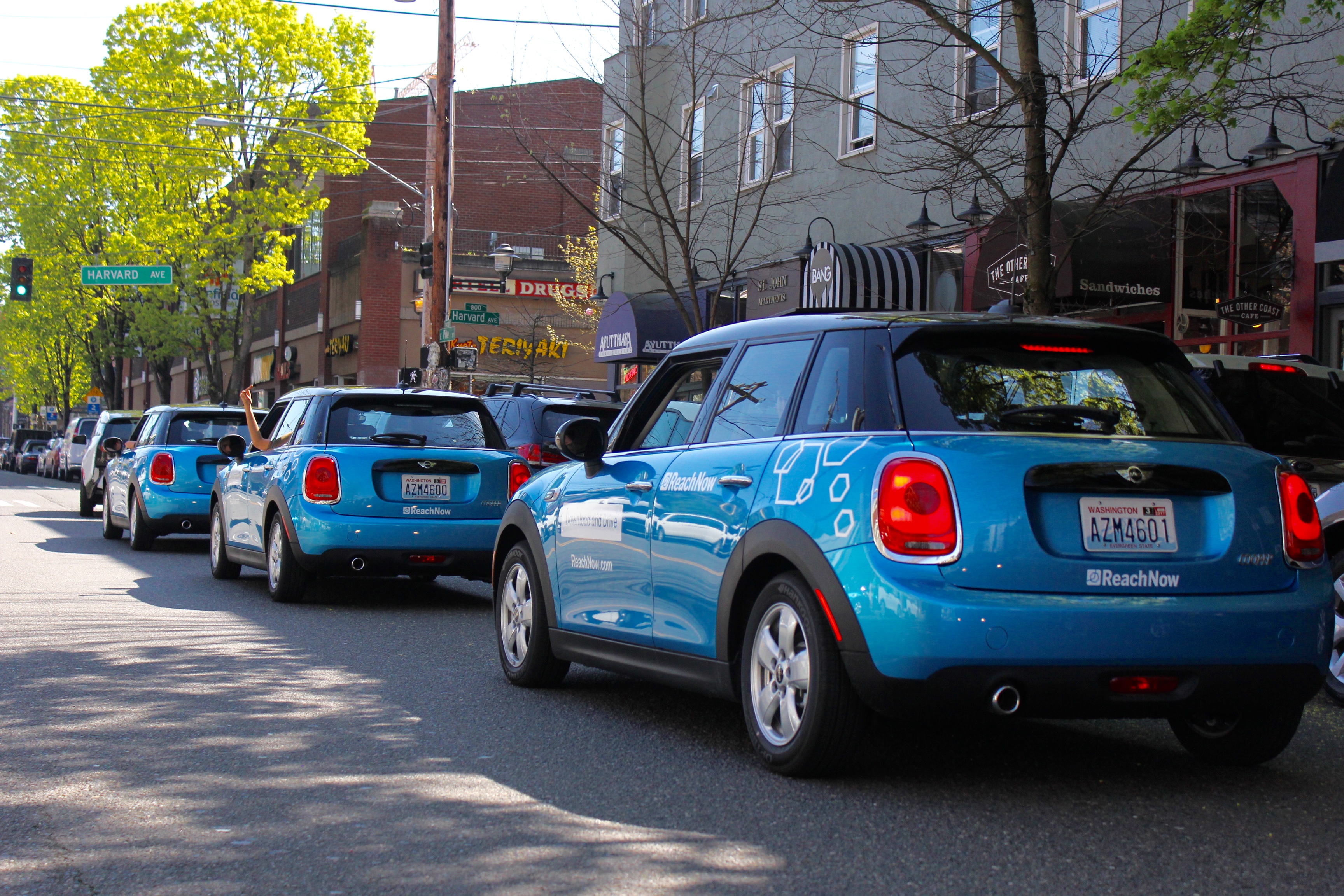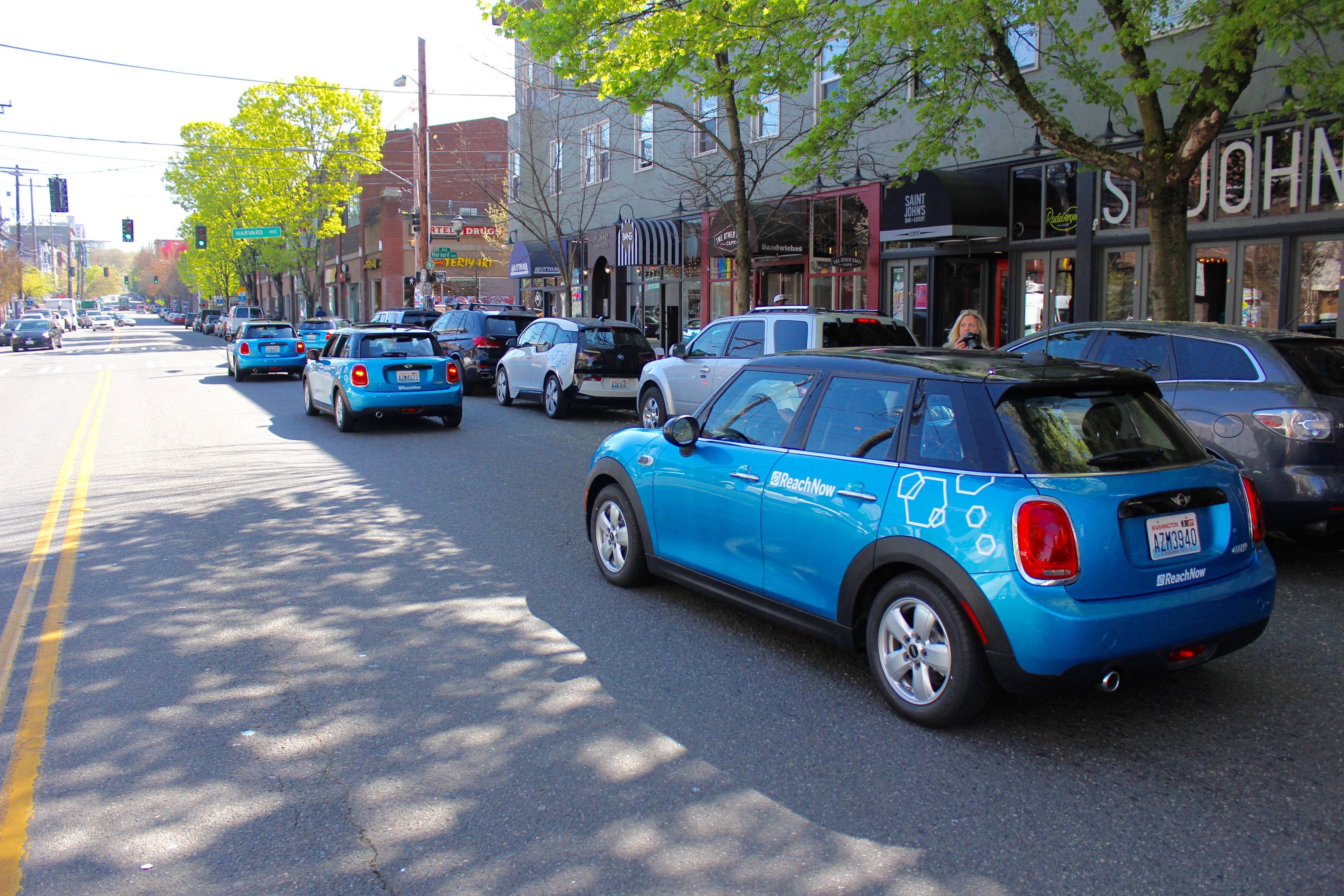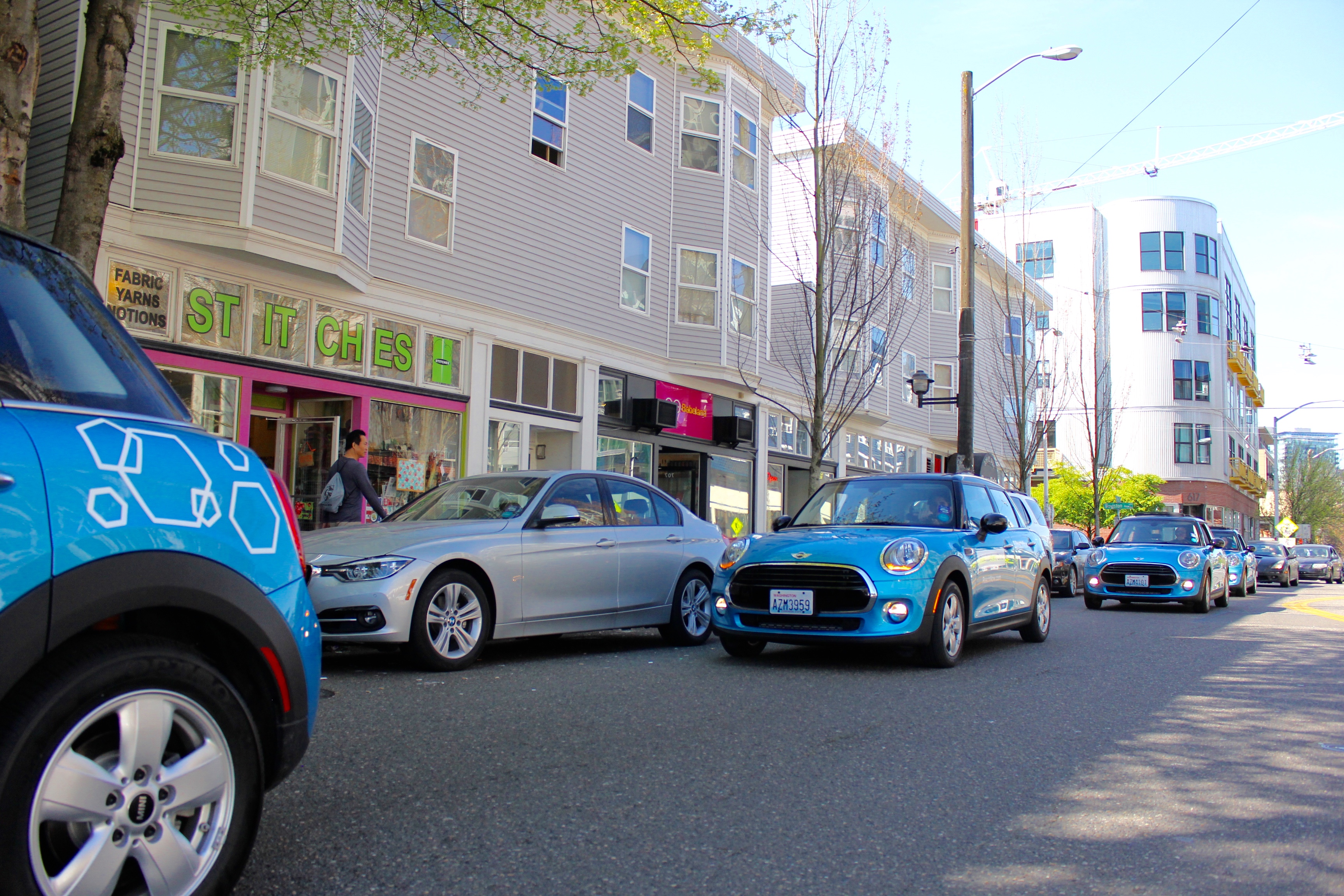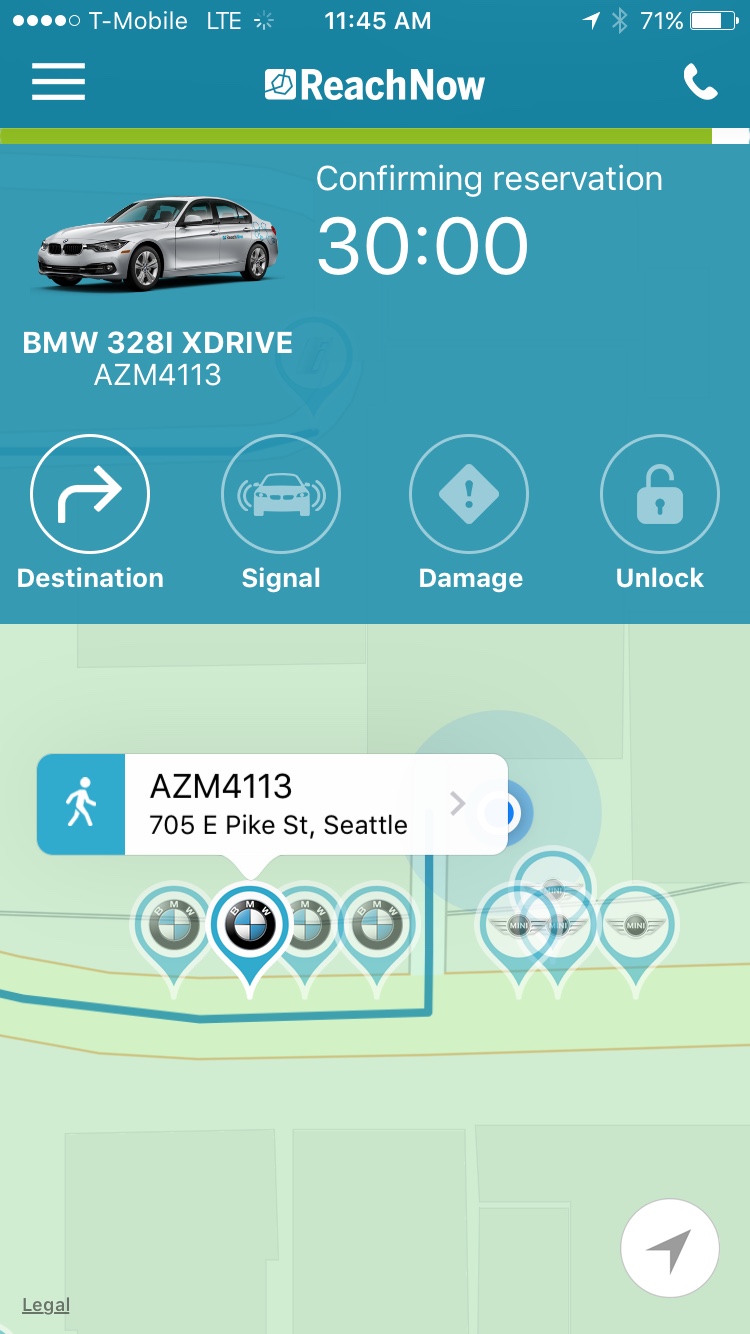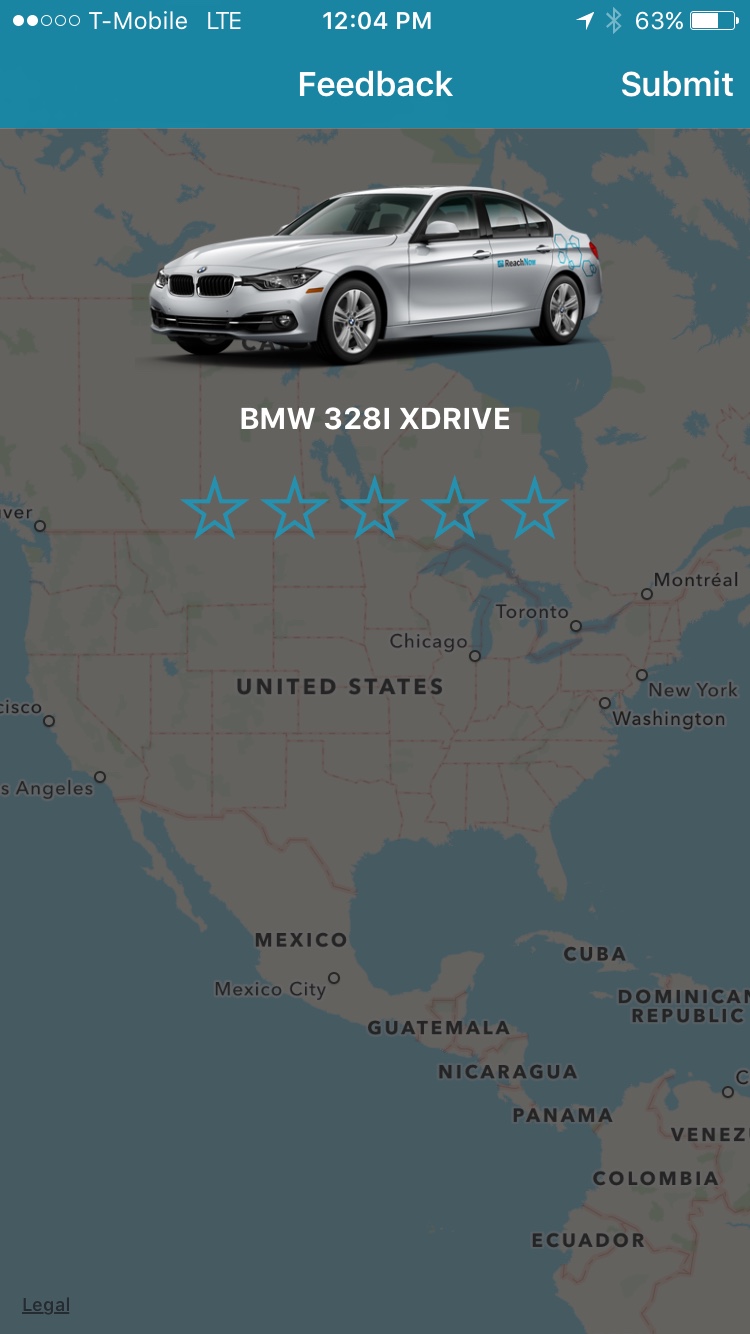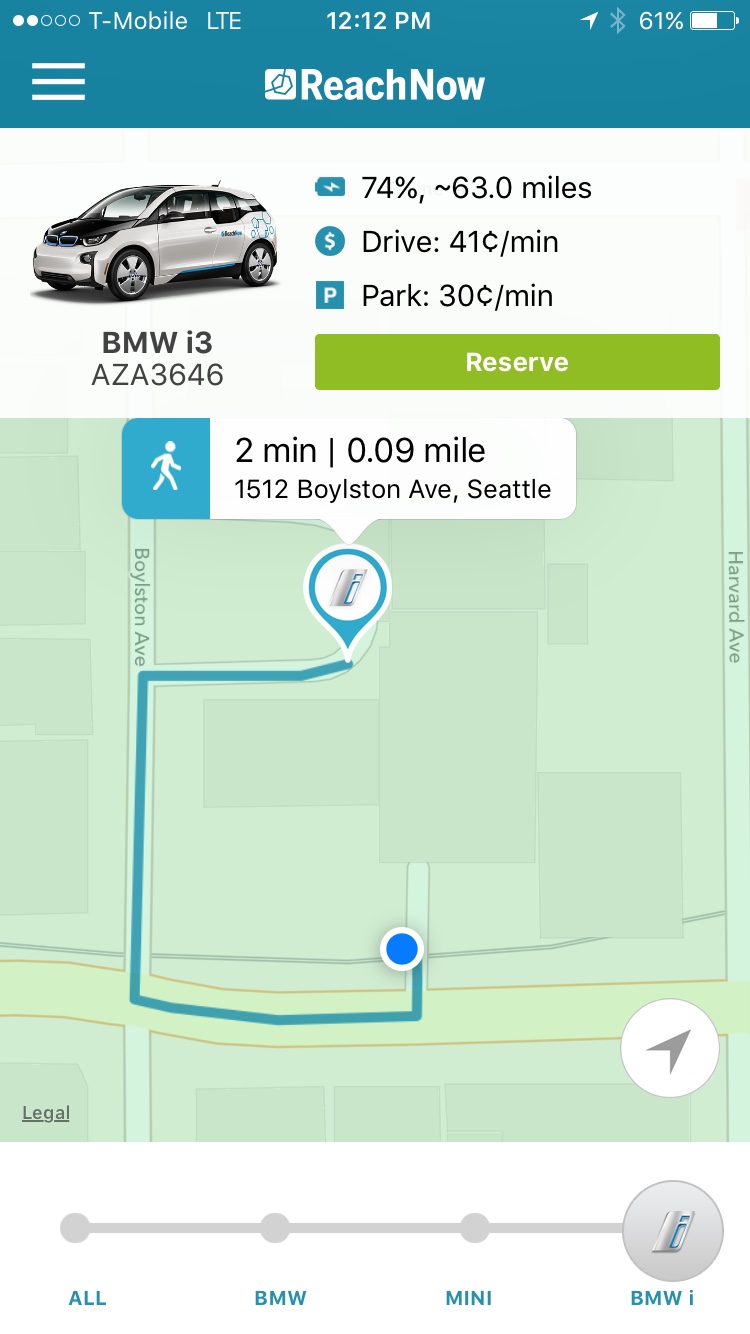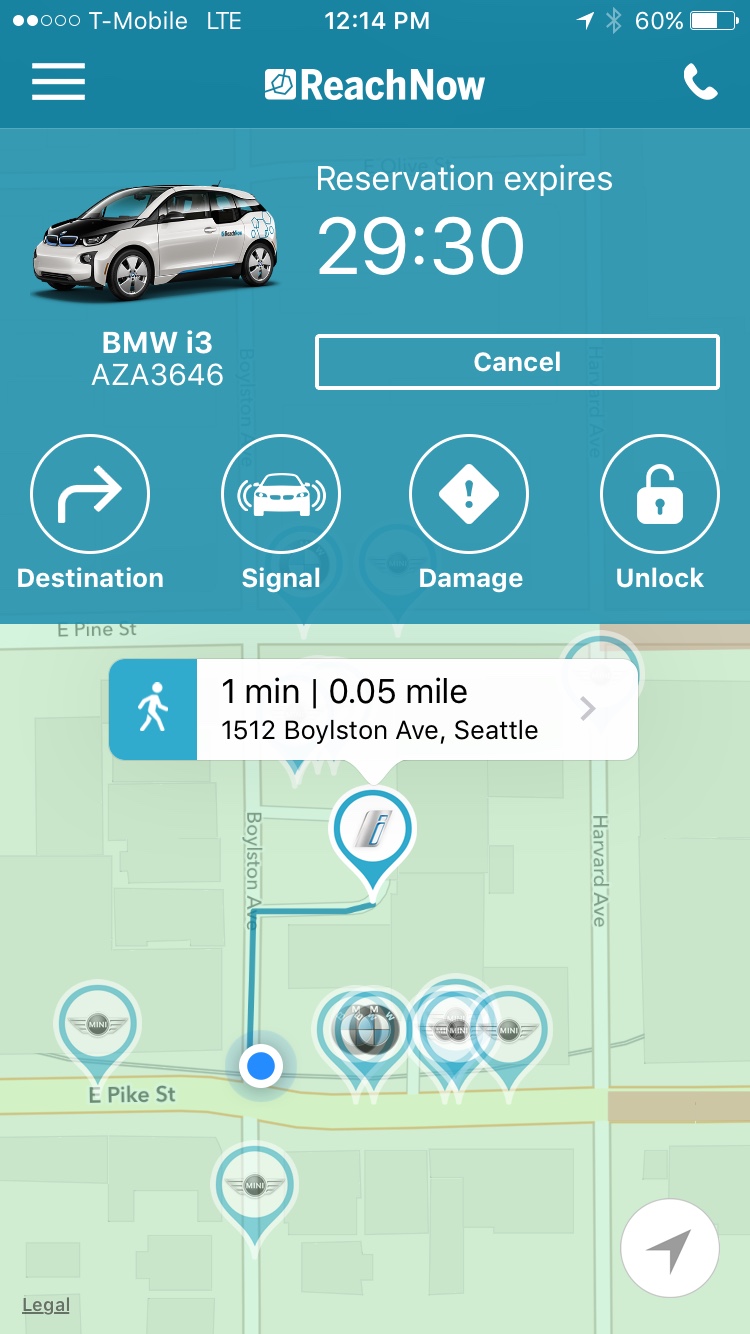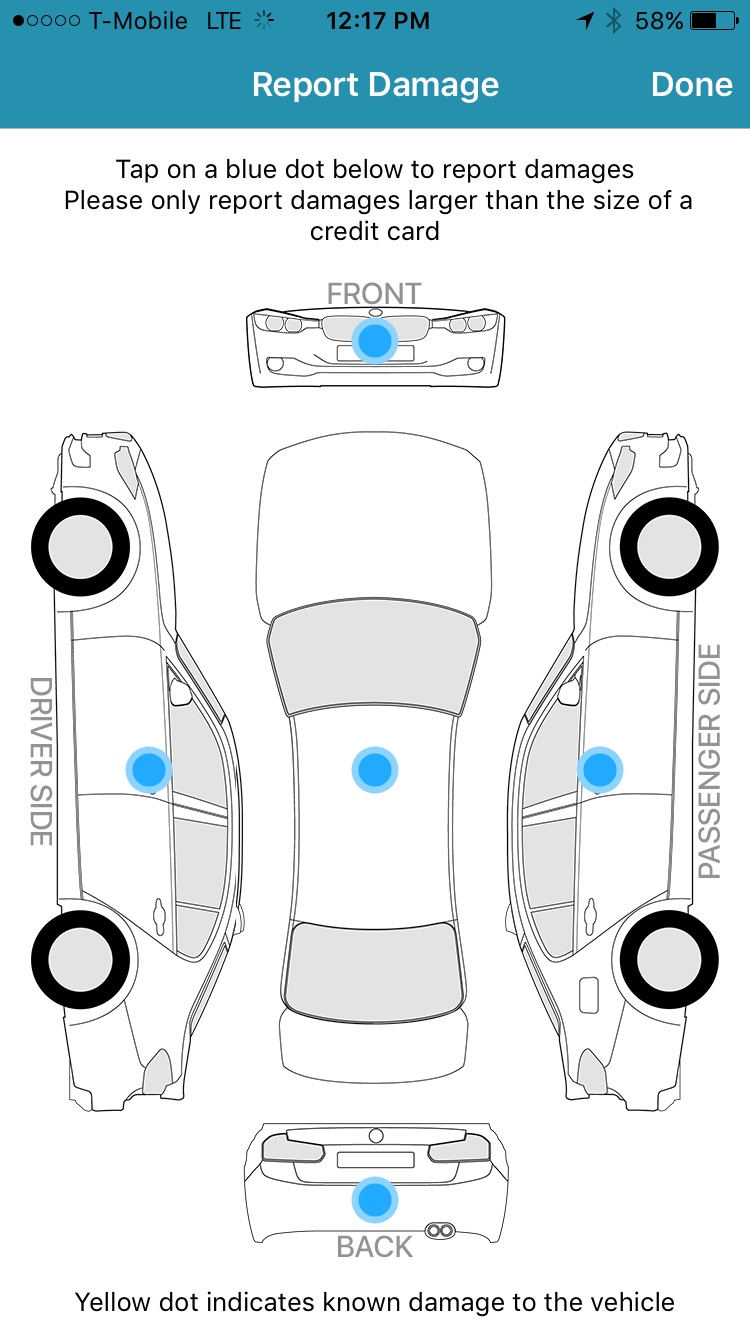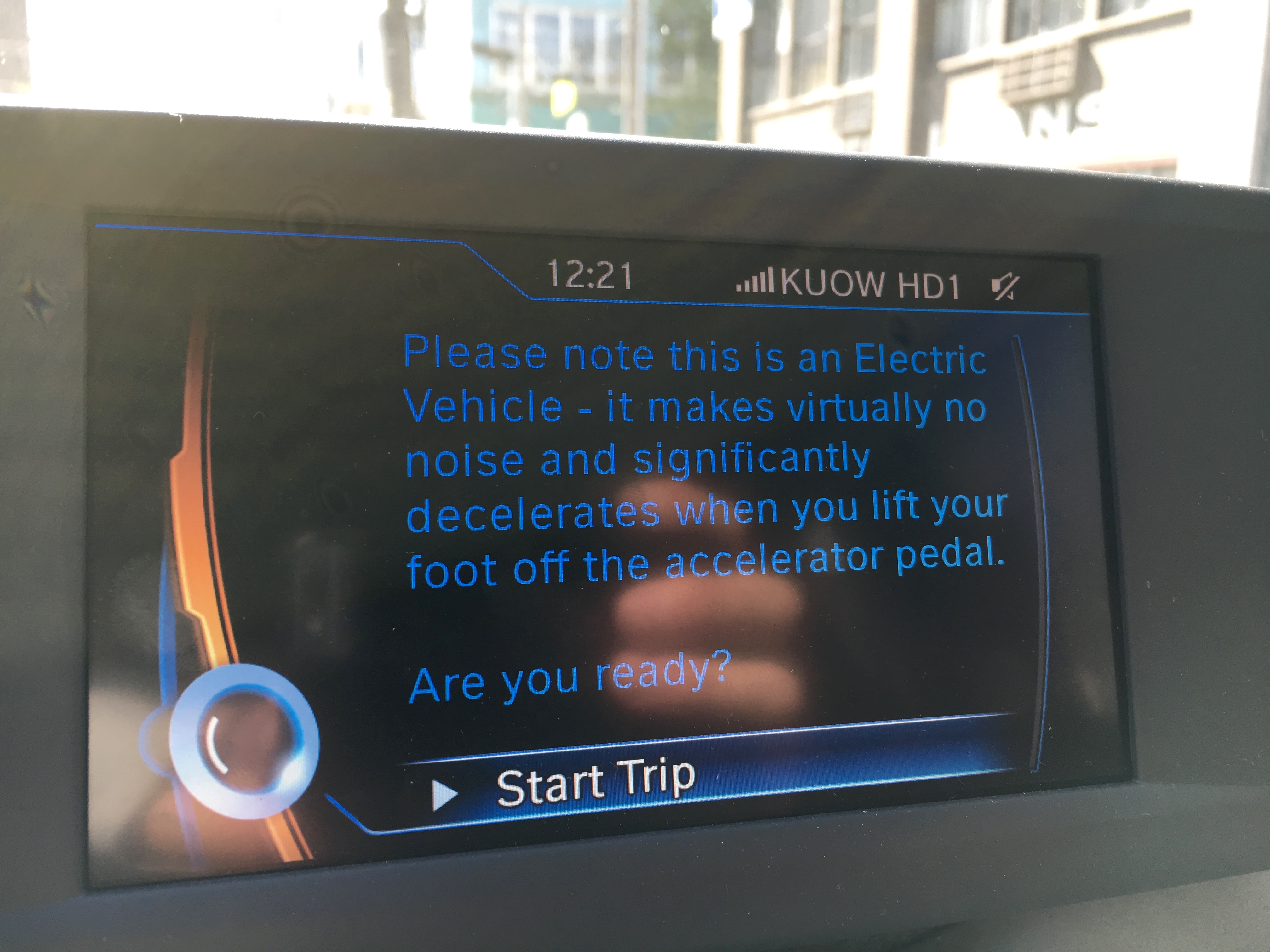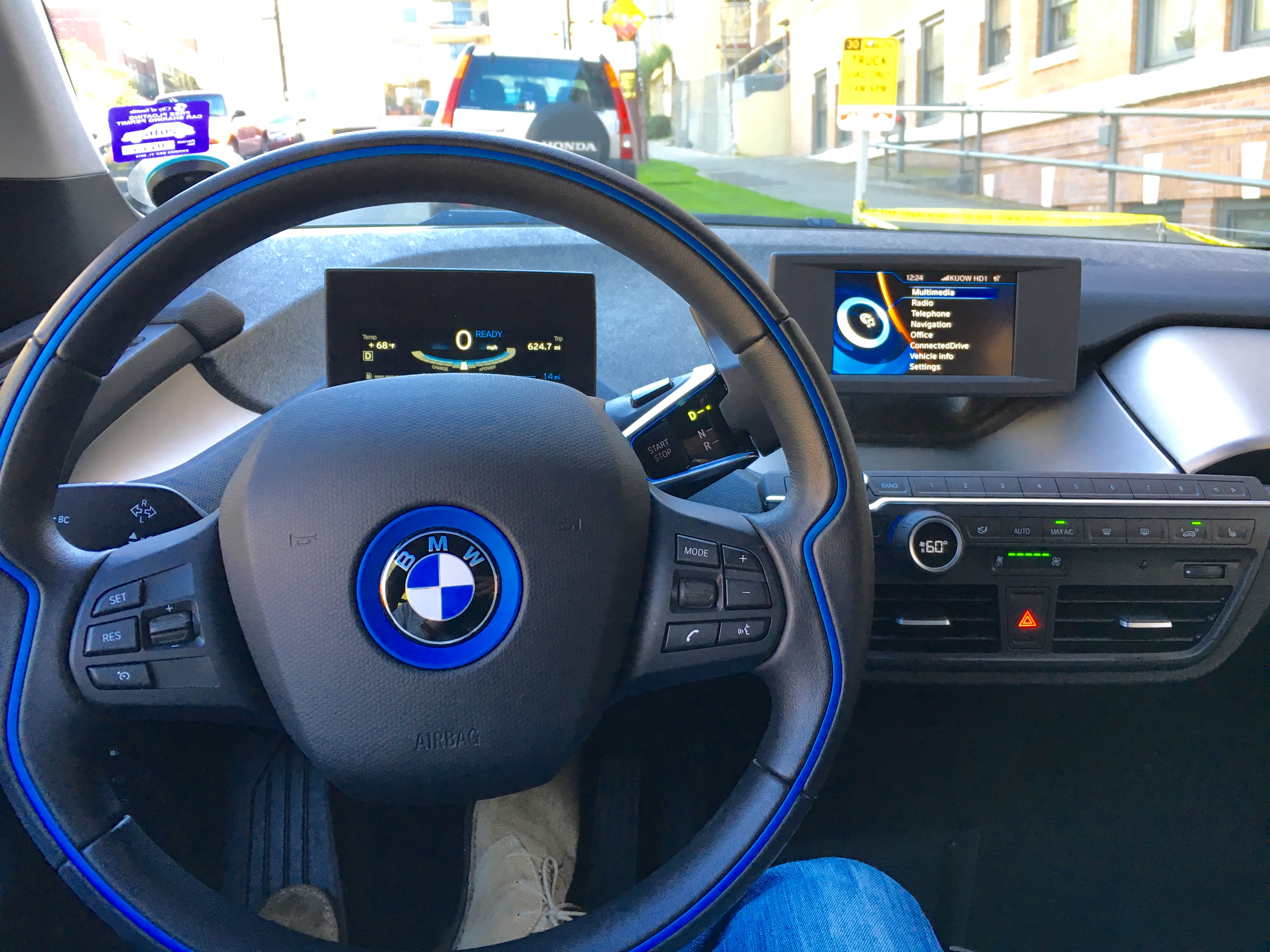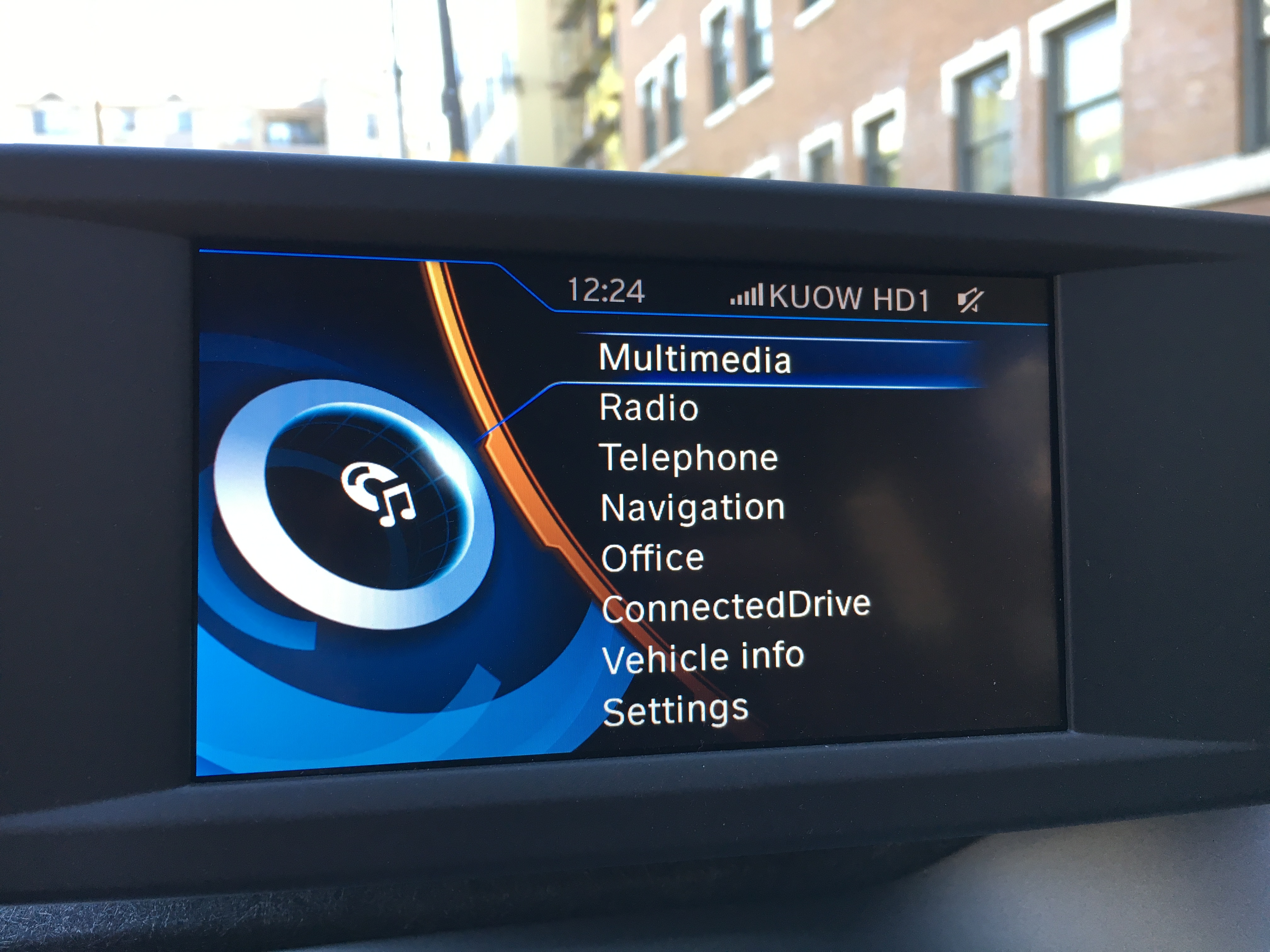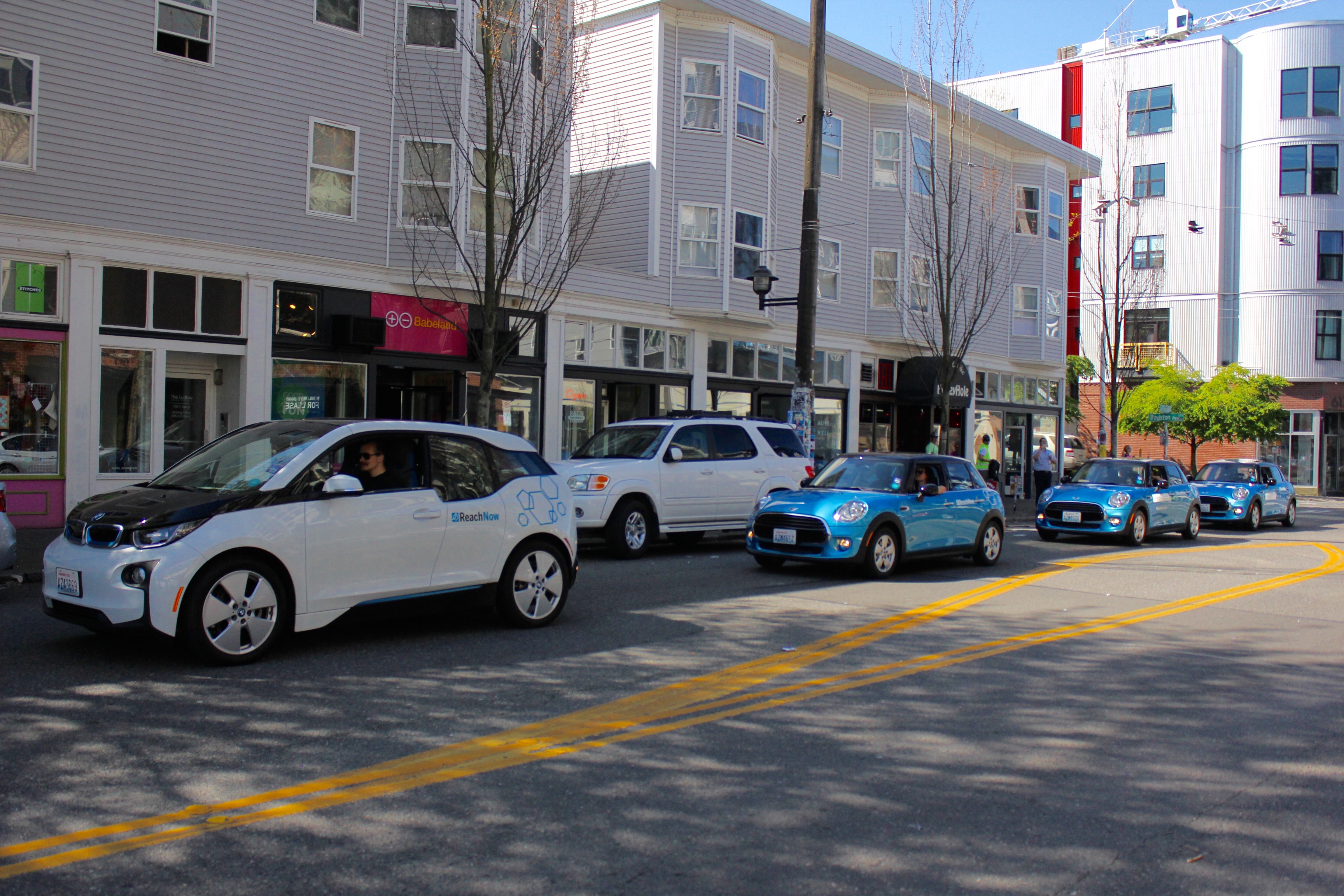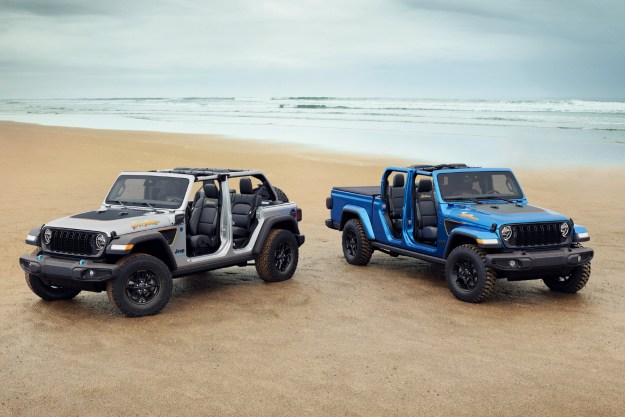This past Friday, BMW launched its ReachNow service in the city of Seattle. Within the crowded Pike Motorworks showroom (a former BMW dealership), BMW Group Board Member, Peter Schwarzenbauer, and ReachNow Chief Customer Officer, Sandra Phillips, introduced the fruits of a labour that began five years ago.
ReachNow was born out of a beta car sharing service that debuted in nine European cities. “DriveNow” grew to 600,000 users and filled BMW’s data logs with 100 million miles of real-world testing. Armed with this intel, the German automaker partnered with RideCell, a Silicon-valley app developer to create what it calls, “mobility on demand.”
The program is part of BMW’s Vision Next 100 that explores the next 100 years of vehicle technology and design. “We want to continue to excite people about mobility, not just products,” said Schwarzenbauer. The company sees a beneficial, non-cannibalizing relationship between ReachNow and its traditional products. Of course, BMW isn’t the first to follow this line of reasoning, as Ford, GM, and other brands begin to test similar tools. Still, BMW is one of the first to offer its service to the general public, and by all accounts, this is no half-baked enterprise.
Beyond getting the in-person download on ReachNow, I was afforded the chance to experience the service and discuss its unique proposition with BMW’s representatives. Is ReachNow genuinely an end-to-end mobility tool, or is it just Bavaria’s take on car sharing?
What Happens When You Register?
After downloading the ReachNow app, you’re greeted by a full-screen map and Uber-style slider on the foot of the screen. Adjusting the slider between BMW, MINI, BMW i, or “All” options updates the map with available vehicles. By selecting a model, you can preview its remaining battery life or fuel reserves, range, and reservation price per minute, but to reserve it, you’ll need to create a profile.
BMW claims you can go through the registration process in two minutes or less, and unlike other services, you never need to leave the app. This is accomplished by entering your first and last name, phone number, address, and email before BMW sends a confirmation PIN via text or email. Next, you’ll need to enter your driver’s license and take a photo of yourself to validate. Finally, snap a photo of your credit card for future payments.
The program kicks off with 70 i3 models, 120 BMW 3 Series’, and 180 MINI Cooper Hatchbacks. Once you choose an available model and tab the “reserve” icon, you can enter a destination, signal the vehicle, report damage, or cancel the reservation. The map also plots the course from your current location to the reserved vehicle. BMW didn’t state whether cancelling your reservation incurs a penalty, but you are allotted 30 minutes to locate the vehicle and initiate the drive before your reservation expires.
The registration and reservation processes is among the simplest I’ve ever experienced, and while BMW’s full range of services, including vehicle delivery, long term loans, car sharing for businesses, and chauffeur services are not yet available, the in-app car sharing functionality is wonderfully simple.
What’s It Like To Use ReachNow?
Once you’ve booked and located your car, it’s time to go for a ride. You can unlock and lock the vehicle’s doors from the app, though it takes a few seconds to communicate between mobile device and vehicle. Alternatively, BMW sends a physical card to each registered user to perform the same functions by tapping the card on the windshield-mounted sticker.
Before you can set off, BMW requires a few more steps to initiate the reservation, all performed within the vehicle’s infotainment system. First, there’s a general welcome screen to let you know that you are indeed in a ReachNow vehicle, not some stranger’s car. Next, you’ll need to enter your unique four-digit PIN (found within the app menu). At this point, if you’ve entered a destination through the app, you’ll be asked to start route guidance. Otherwise, simply select “start the trip,” to get moving.
Only after you follow these prompts will you be allowed to start the vehicle. One thing I learned from a strangely warm Seattle Spring day is that if it’s your first time figuring out the process, you’d better leave a door open so you don’t overheat. That lovely air conditioning is reserved for those who follow directions.
After you’ve satisfied the car’s demands, the app will begin recording your drive time, billing at a rate of $0.49 cents per minute of operation ($0.41 cents per minute during ReachNow’s “introductory period) or $0.30 cents per minute when the vehicle is parked. If you’ve reserved a BMW i3, critical information like nearest charge stations and range are displayed prominently on the driver display and infotainment system, while the petrol-powered MINI and 3 Series are business as usual. Fill-ups are included in the service, but better yet is that BMW has negotiated free parking at all meters in Seattle.
How Is ReachNow Unique?
Now to evaluate BMW’s claim of “complete mobility.” On paper, ReachNow’s list of services is unmatched at this stage; car sharing, chauffeur services, long term rentals, and vehicle deliveries have been done at this point, but never as an inclusive package. BMW also spoke briefly of its plan to offer MINI and BMW customers the chance to list their own vehicles for rent on ReachNow. Not only do owners benefit by monetizing their cars while out of town, BMW benefits from an expanded fleet of vehicles. As the automaker rolls out these additional features over the coming weeks and months, it will be interesting to see how users sample each function (or don’t), and more importantly, how BMW adapts to customer demands.
While the automaker touts a full range of mobility services as its most distinctive factor, I actually found the less-publicized elements of ReachNow to be its most innovative. First, the RideCell platform on which ReachNow is based is incredibly detailed. Instead of merely building an app for any given city, RideCell tailors its service to the environment, infrastructure, and regional laws. “RideCell thinks about integrating into the fabric of a city, not just layering our platform on top of a community,” said RideCell CEO Aarjav Trivedi.
It’s not just the software; BMW worked extensively with the city of Seattle to roadmap operations for years of collaboration. “Providing affordable, connected, sustainable transportation options is what we’re all about here in Seattle,” said Deputy Mayor Kate Joncas. That attitude and the openness to ReachNow’s free floating service prompted BMW to invest in Seattle as opposed to, say, San Francisco, where there are several obstacles to this level of mobility service. The automaker has plans to introduce ReachNow to at least 10 major cities in North America, though it didn’t specify which ones at this point. For now, the spotlight is on Seattle, where BMW will headquarter ReachNow.
Then there’s the focus BMW has placed on electric vehicles. Though ReachNow’s fleet contains a minority share of i3’s, the limiting factor is charging infrastructure. “As consumer demands for electric vehicles become more clear, we will work with each city to grow charging options,” said Schwarzenbauer. “We believe this service will help promote electric driving, to overcome the stigma that electric driving is boring.” At this point, most people will have to buy or lease an EV to experience “living” with one, but through ReachNow, and especially for longer-term rentals, urban dwellers will have the opportunity to drive and judge electric cars with no strings attached.
What’s Next For BMW’s Mobility Initiative?
“This is mobility 1.0 – the starting point to get to all these other services,” said Phillips. “I see the future, mobility 2.0, as broader exposure of this service, fulfilling all mobility needs for customers on a global scale. Whatever customer feedback we receive will be fed into what we develop next – the vehicles, the infrastructure, etc. We want to meet mobility needs as they develop, so in some ways it’s hard to predict what needs might arise over time.”
It’s light on specifics, but BMW’s approach is spot on. Being first among its peers to introduce a more holistic mobility platform gives the company an opportunity to learn what consumers really want and need out of service like this, and to adjust its approach based on those insights, before rivaling services ever hit the market.
While consumers continue to purchase and lease vehicles in strong numbers, mobility services will at some point match, and possibly overtake the industry as a usage trend. BMW is choosing to ride the wave of change instead of being crushed by it.
